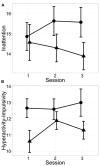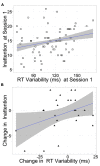Tai chi training reduces self-report of inattention in healthy young adults
- PMID: 24478679
- PMCID: PMC3902356
- DOI: 10.3389/fnhum.2014.00013
Tai chi training reduces self-report of inattention in healthy young adults
Abstract
It is important to identify effective non-pharmacological alternatives to stimulant medications that reduce symptoms of attention deficit hyperactivity disorder (ADHD). In this study of healthy young adults, we measured the effects of training in tai chi, which involves mindful attention to the body during movement. Using a non-randomized, controlled, parallel design, students in a 15-week introductory tai chi course (n = 28) and control participants (n = 44) were tested for ADHD indicators and cognitive function at three points over the course of the 15-weeks. The tai chi students' self-report of attention, but not hyperactivity-impulsivity, improved compared to controls. At baseline, inattention correlated positively with reaction time variability in an affective go/no-go task across all participants, and improvements in attention correlated with reductions in reaction time variability across the tai chi students. Affective bias changed in the tai chi students, as reaction times to positive- and negative-valenced words equalized over time. These results converge to suggest that tai chi training may help improve attention in healthy young adults. Further studies are needed to confirm these results and to evaluate tai chi as therapy for individuals with ADHD.
Keywords: Tai chi; attention deficit disorder with hyperactivity; college students; meditation; mindfulness; non-pharmacological intervention; young adults.
Figures



Similar articles
-
Tai Chi training for attention deficit hyperactivity disorder: A feasibility trial in college students.Complement Ther Med. 2020 Sep;53:102538. doi: 10.1016/j.ctim.2020.102538. Epub 2020 Aug 14. Complement Ther Med. 2020. PMID: 33066865 Free PMC article.
-
The appeal of tai chi and complementary therapies for college students with ADHD.J Am Coll Health. 2023 Dec;71(9):2628-2638. doi: 10.1080/07448481.2021.1990071. Epub 2022 Jan 19. J Am Coll Health. 2023. PMID: 35044884
-
Four-week Tai Chi intervention decreases attention bias to drug cues in individuals with methamphetamine use disorder.Am J Drug Alcohol Abuse. 2021 Sep 3;47(5):638-648. doi: 10.1080/00952990.2021.1950745. Epub 2021 Jul 30. Am J Drug Alcohol Abuse. 2021. PMID: 34325579
-
The Effects of Long-Acting Stimulant and Nonstimulant Medications in Children and Adolescents with Attention-Deficit/Hyperactivity Disorder: A Meta-Analysis of Randomized Controlled Trials.J Child Adolesc Psychopharmacol. 2018 Oct;28(8):494-507. doi: 10.1089/cap.2017.0151. Epub 2018 Jun 13. J Child Adolesc Psychopharmacol. 2018. PMID: 29897263 Review.
-
Does mindfulness meditation improve attention in attention deficit hyperactivity disorder?World J Psychiatry. 2015 Dec 22;5(4):397-403. doi: 10.5498/wjp.v5.i4.397. eCollection 2015 Dec 22. World J Psychiatry. 2015. PMID: 26740931 Free PMC article. Review.
Cited by
-
Effectiveness of Tai Chi Exercise Program on Sleep, Quality of Life, and Physical Performance in Postmenopausal Working Women.J Midlife Health. 2022 Apr-Jun;13(2):127-132. doi: 10.4103/jmh.jmh_223_21. Epub 2022 Sep 16. J Midlife Health. 2022. PMID: 36276631 Free PMC article.
-
Mind-Body Therapy for Children with Attention-Deficit/Hyperactivity Disorder.Children (Basel). 2017 Apr 25;4(5):31. doi: 10.3390/children4050031. Children (Basel). 2017. PMID: 28441363 Free PMC article. Review.
-
Comparing the Changes in Blood Pressure After Acute Exposure to Tai Chi and Walking.Int J Exerc Sci. 2019 Jan 1;12(3):77-87. doi: 10.70252/AAUX3960. eCollection 2019. Int J Exerc Sci. 2019. PMID: 30761199 Free PMC article.
-
Tai Chi training for attention deficit hyperactivity disorder: A feasibility trial in college students.Complement Ther Med. 2020 Sep;53:102538. doi: 10.1016/j.ctim.2020.102538. Epub 2020 Aug 14. Complement Ther Med. 2020. PMID: 33066865 Free PMC article.
-
Effects of mind-body exercise on individuals with ADHD: a systematic review and meta-analysis.Front Psychiatry. 2024 Dec 9;15:1490708. doi: 10.3389/fpsyt.2024.1490708. eCollection 2024. Front Psychiatry. 2024. PMID: 39717371 Free PMC article.
References
-
- American Psychiatric Association (2000). Diagnostic and Statistical Manual of Mental Disorders: DSM-IV-TR 4th Edn Washington, DC: American Psychiatric Association
-
- Barnes P. A. (2004). Complementary and alternative medicine use among adults: United States, 2002. CDC Adv. Data 343 1–19 - PubMed
-
- Briggs R. C., Gossman M. R., Birch R., Drews J. E., Shaddeau S. A. (1989). Balance performance among noninstitutionalized elderly women. Phys. Ther. 69 748–756 - PubMed
Grants and funding
LinkOut - more resources
Full Text Sources
Other Literature Sources
Medical

